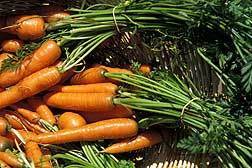
Daucus carota var.sativus
Carrots are root vegetables, usually orange, white or red in color and have a woody texture. The edible part of a carrot is its long taproot.
Carrots do not transplant well. Sow seeds directly into the garden about two week before the last expected frost. Plant another crop for fall in mid-summer. Warm climates can plant every three weeks until 2 1/2 months before the first frost.
full sun
light, well-drained, nutrient-rich soil tilled to a depth of at least 8 inches; plant shorter cultivars in areas with heavy soil
Keep soil evenly moist (not wet) until seeds germinate. Once carrots have been thinned, reduce the amount of water you give them to avoid cracking the roots. If warm weather begins to dry the soil out, remoisten it slowly over a period of several days.
When seedlings reach 2 inches tall, thin them to 1 inch apart by hand or with a rake. Thin them again two weeks later to 3 to 4 inches apart.
Harvest carrots as soon as they are big enough to eat. Carrots left in the ground too long will taste woody.
Most carrot diseases are soil-borne and can be minimized by practicing crop rotation. Watch for rust fly, carrot weevils and wireworms.
Depending on variety, carrot seeds can take from 7 to 20 days to germinate. Speed germination by spreading seeds between two damp paper towels. Keep the paper towels in the refrigerator and check them daily. When white root tips appear, mix the seed in with a little bit of fine sand and sow the mixture directly into the garden.
Carrots exposed to light turn green and taste bitter so mound up soil to keep the tops of roots covered.

Add your voice! Click below to comment. ThriftyFun is powered by your wisdom!
thank u for this info...i decided 2 plant my own veggies n carrots r definitely 1 of my favorites..
dru
Add your voice! Click below to comment. ThriftyFun is powered by your wisdom!